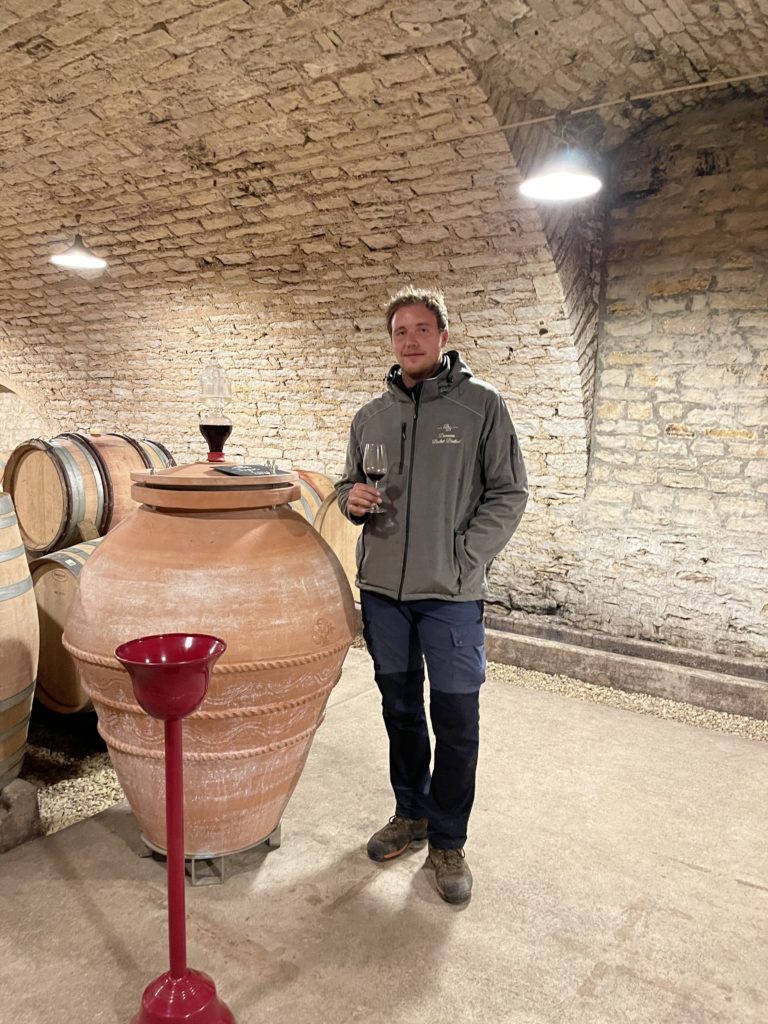I’ve been wanting to visit Domaine Ghislaine Barthod for years, but due to misunderstandings it never came to pass. I was disappointed about this, as I have always admired the wines made at this estate.

Now times and my luck have changed, and Ghislaine’s son Clément Boillot has taken over his family’s wine portfolio, consisting of three domaines: one in Beaujolais, Domaine Louis Boillot (from his father), and Domaine Ghislaine Barthod from his mother.
So, a big transformation, although not necessarily in style. Still, big changes for Clément, whose early experience was in the Beaujolais part of the business.
I have therefore chosen to divide this article into its three constituent parts, starting out with Beaujolais.
Rating Beaujolais
The emotional ratings (the hearts) are very important as always, but I also give a regular points rating.
I rarely give Beaujolais more than 90 points, which is for me a good score along the lines of a fine village-level wine from Burgundy’s main villages. Equally, I will rarely give a Bourgogne rouge a rating beyond 90 points or so. Some think these ratings are too low; but this is how I ensure consistency across all wines and terroirs.
Given this context, even the best Beaujolais should not be rated higher than a Chambolle Musigny Les Cras, as Les Cras is a better, more complex terroir – in my book at least.
Home turf – in Beaujolais
Clément Boillot originates from Burgundy, but made his debut as a winemaker in Beaujolais, which is his home turf so to speak. That said, his Chambolle roots are difficult to hide, despite the change in grape variety between the Cote de Nuits and Beaujolais.
Clément is making Beaujolais in the style of Burgundy – or should I say Chambolle- or Pommard-style – creating a link among the different parts of the estate.
The Clément Boillot wines are not happy-go-hippie Beaujolais, but rather more traditionally made – some destemming, and with a sulphur level built to last.
I taste many hippie Beaujolais with very little sulphur, and often made with only whole-cluster grapes, so the Boillot wines are a welcome variation and change. With the rarity and increasing prices of Burgundian wines, viable alternatives are welcome, and needed.
Domaine Louis Boillot Moulin-a-Vent Vieilles Vignes 2020
The Moulin-a-Vent Vieilles Vignes is a forward entry point to the Beaujolais portfolio, and uses only 15% whole clusters. It’s vivid and slightly crude, and somehow I enjoy it for this expressive display that should always feature in good Beaujolais. This is a debate: Should Beaujolais always be forward and fruity? Or could one expand the depth and complexity of these wines to serve a finer purpose? I don’t have the answer, but I do prefer when energy and liveliness are evident in the wines.
(Drink from 2022) – Good+ – (87p) – ![]()
Domaine Louis Boillot Moulin-a-Vent Les Rouchaux
A very enjoyable wine with a lovely, Burgundian take on Beaujolais (if one is allowed to say this). It has a vivid, almost pinot-like character which really appeals to my Nuiton heart. This has the lively energy I search for. What a treat, with quite an intense mid-palate.
(Drink from 2024) – Very Good – (88p) – ![]()
Domaine Louis Boillot Moulin-a-Vent Les Brussellion
Denser and clearly more Beaujolais than the previous wines, this is an intense wine that presumably comes from richer, clay-based soil. Not really revealing itself at the moment, but will definitely shine in the long run. Almost too robust for the ‘Hog’s palate.
(Drink from 2025) – Very Good – (87p)
You need to login as a Premium subscriber to read the rest of this article. If you are not a Premium Subscriber, use the subscribe function and sign-up.

 - A true vin d’émotion – a Burgundy of passion
- A true vin d’émotion – a Burgundy of passion - A truly hedonistic wine – lively and enjoyable
- A truly hedonistic wine – lively and enjoyable - A vivacious wine for pure indulgance
- A vivacious wine for pure indulgance - A potential vin d´émotion - frais et léger
- A potential vin d´émotion - frais et léger
Leave a Reply
You must be logged in to post a comment.